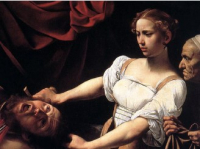
Fear and Loathing in the Earthly City. Negative Emotions in the Medieval and Early Modern Period c. 1100-1700
CML associate professor Thomas Heebøll-Holm blogs about this conference (November 1-2, 2018, Copenhagen).
This two-day conference was jointly organized by the Centre for Medieval Literature and the Department of History at the University of Southern Denmark and the Danish National Museum. It originated from the three organizers' interest in emotional history as an approach not only to their own areas and time periods of expertise, but also how these emotions could be studied in a longue durée perspective. Moreover, the history of the emotions has the advantage that emotions and ideas of emotions are (relatively) comparable over time, and is a powerful tool in breaking down the artificial boundaries between the academic disciplines such as history, literary studies, and art history to name but a few. As we, the organisers, had a common interest in the more negative emotions such as fear, hate, envy etc. and how they were deployed in the Middle Ages and the Early Modern Period, we quickly decided on that to be our take on this particular conference.
For two days twenty-five speakers discussed various aspects of emotions and especially negative ones in the period from the twelfth to the eighteenth centuries. The many papers generated many thought-provoking presentations and discussions. To name a few, Craig Taylor (University of York) in his keynote paper addressed the role of shame in chivalric culture. He demonstrated how shame was used strategically (in this case by Marshal Boucicaut) both to boost one’s status, but also how the chivalric concepts of shame were being opposed by the increasingly bureaucratic French royal government. To such an institution, emotions ran counter to the goals of the state and were in effect counterproductive to a rising culture of raison d’état. Another keynote speaker, Bonnie Clementsson (University of Lund) discussed the possible differences between medieval and modern emotions of anger and love in court cases and the possibility of a break around 1750. This paper tackled the question of periodization and emotions head-on and permitted for a fruitful and lively discussion about possible differences in terms of the use and understanding of emotions post and prior to the emergence of modernity. In regards to the interrelatedness of literature and social history, Marc B. Cels (Athabasca University) presented a very stimulating and amusing paper on anger, anguish and peasants in the Chaucer’s Summoner’s Tale. Here emotions and indeed crude jokes played a pivotal role in identifying social groups. Moreover, to this Danish blogger, he provided an explanation of the term ‘pisse-myre’ – piss-ant, used by Chaucer. This is all more interesting, since I have always had the impression that this term was purely Danish. Cels’ paper very nicely tied literature, emotions and social history to provide a snapshot of late medieval English life thereby demonstrating the strength of the emotional approach to classic texts. Finally, Daniel McCann presented a highly interesting analysis of the “Prickynge of Love” which through the study of emotions combined theology and medicine to gain a new understanding the interconnectedness of the view of emotions and health in the later Middle Ages.
All in all the conference was extremely inspiring. It clearly demonstrated the strength of the study of emotions as a tool not only to unveil new layers of well-known texts but also as a means to strengthen interdisciplinary and cross-period studies.